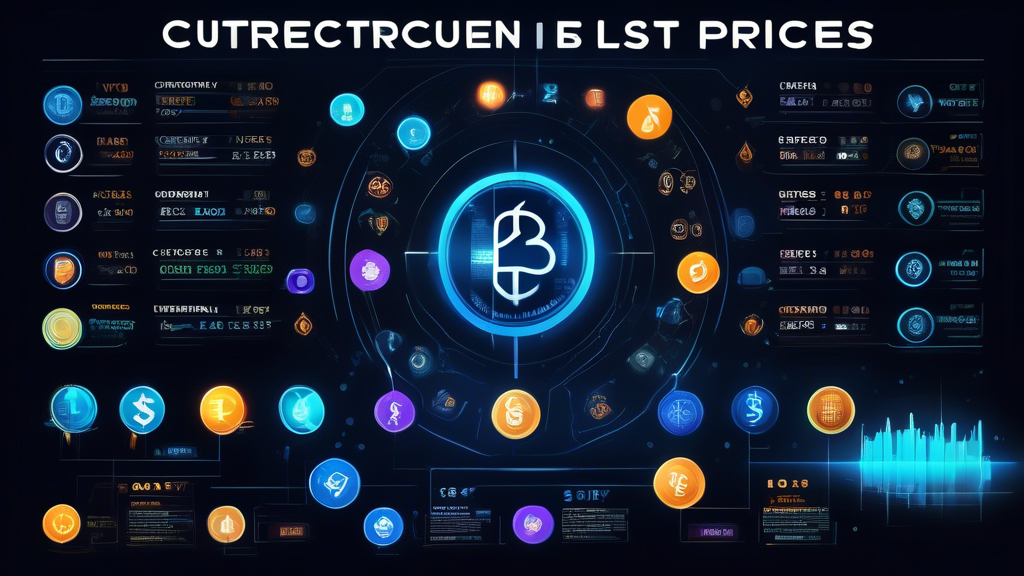Current Cryptocurrency List Prices: An In-Depth Overview
Understanding Cryptocurrency List Prices: Key Terms and Metrics
Welcome to our comprehensive guide on current cryptocurrency list prices. If you are a seasoned investor or a newcomer to the digital currency market, understanding cryptocurrency list prices is crucial for making informed decisions. In this section, we will break down key terms and metrics associated with cryptocurrency pricing to provide you with a solid foundation.
At its core, a cryptocurrency list price is the current rate at which a specific digital currency can be bought or sold. These prices are dynamic, updating in real-time based on numerous market factors. Key terms you need to be familiar with include market capitalization (market cap), which represents the total value of all coins in circulation, and trading volume, which indicates the amount of a cryptocurrency traded within a given period.
List prices are primarily determined by supply and demand dynamics, and they are set on cryptocurrency exchanges where buyers and sellers interact. Various algorithms and market forces come into play, ensuring that the list prices reflect the prevailing market conditions at any given moment.
Factors Influencing Current Cryptocurrency List Prices
Several factors influence the current cryptocurrency list prices, making the market both exciting and volatile. Market demand is one of the most significant factors; as more people buy in, the higher the prices can climb. Conversely, large sell-offs can drive prices down. Regulatory news also plays a critical role. Announcements from government bodies about new regulations or bans can cause significant fluctuations in the market.
Technological advancements, such as updates to blockchain technology or the introduction of new features, can also impact prices. For instance, significant upgrades to a cryptocurrency’s underlying technology can boost investor confidence, leading to price surges. Additionally, investor sentiment and market trends are powerful drivers. Positive news, endorsements by influential figures, or general market optimism can spur buying frenzy, while negative news can have the opposite effect.
Analyzing the Latest Cryptocurrency List Prices: Top Performers and Laggers
As we dive into the latest cryptocurrency list prices, it’s essential to identify top performers and laggers in the market. Some cryptocurrencies consistently lead the pack with robust performance metrics and strong market capitalization. These top performers often gain traction due to their technological advancements, strong community support, and widespread adoption.
Conversely, some cryptocurrencies struggle to maintain their value. Various factors, including poor technological feasibility, lack of development activity, or negative market sentiment, contribute to their lagging performance. Analyzing recent price trends provides valuable insights into market dynamics and helps investors make better decisions.
We will explore these trends and provide detailed analysis to help you navigate the dynamic world of cryptocurrency investments effectively.
Understanding Cryptocurrency List Prices: Key Terms and Metrics
When navigating the ever-evolving world of digital assets, understanding cryptocurrency list prices is crucial. This knowledge can empower you to make informed decisions, whether you’re an investor, trader, or simply an enthusiast. Below, we explore what a cryptocurrency list price is, the key terms associated with cryptocurrency pricing, and how these prices are determined and set.
What is a Cryptocurrency List Price?
The cryptocurrency list price is essentially the current price at which a specific cryptocurrency is being traded on exchanges. This price is updated in real-time and reflects the most recent transaction value of the cryptocurrency. For anyone looking to buy or sell digital assets, the list price serves as a primary reference point, offering immediate insight into the market value of the asset in question.
Key Terms Associated with Cryptocurrency Pricing
To effectively understand and analyze cryptocurrency list prices, it’s vital to familiarize yourself with several key terms and metrics:
Market Capitalization (Market Cap)
Market capitalization is calculated by multiplying the current price of the cryptocurrency by its total circulating supply. This metric provides a broader view of the cryptocurrency’s overall market value and is often used to rank cryptocurrencies. A higher market cap usually indicates a more established and trustworthy asset, but not necessarily a safe investment.
Trading Volume
Trading volume refers to the total amount of a cryptocurrency that has been traded within a specific time frame, usually 24 hours. High trading volumes often indicate strong interest and liquidity, meaning the asset is easier to buy and sell without causing significant price movements. Conversely, low trading volumes might imply lower interest or potential price manipulation.
Circulating Supply
The circulating supply of a cryptocurrency is the total number of coins or tokens that are currently available in the market and accessible to the public. Unlike traditional stocks, where the total number of shares is usually fixed, the circulating supply of cryptocurrencies can change over time due to factors like mining, staking, and buybacks.
Price Volatility
Cryptocurrencies are notorious for their price volatility, which measures the rate at which the price of an asset increases or decreases over a particular period. High volatility can offer lucrative opportunities for traders but also represents a significant risk, making it crucial to understand and manage this metric.
How Are Cryptocurrency List Prices Determined?
Cryptocurrency list prices are primarily determined by market forces — specifically, the laws of supply and demand. When the demand for a cryptocurrency exceeds its supply, the price tends to rise. Conversely, when the supply exceeds demand, the price generally falls. Several other factors also play a role in determining these prices.
The Role of Cryptocurrency Exchanges
Cryptocurrency exchanges are platforms where buyers and sellers can trade digital assets. These exchanges are pivotal in setting list prices through the interaction of buy and sell orders. Popular exchanges like Binance, Coinbase, and Kraken aggregate these orders and match buyers with sellers at mutually agreed-upon prices. Thus, the list price often reflects the most recently executed trade.
Influence of Market Sentiment
Market sentiment, or the overall attitude of investors toward a particular asset, can significantly influence cryptocurrency list prices. Positive news, such as regulatory approval, technological advancements, or major partnerships, can drive up prices. On the other hand, negative news, such as security breaches or regulatory crackdowns, can cause prices to plummet.
Trading Bots and Algorithms
In the modern trading environment, automated trading bots and algorithmic strategies also impact cryptocurrency list prices. These tools can execute high-frequency trades, taking advantage of small price discrepancies across different exchanges. While this can contribute to market efficiency, it can also introduce additional volatility, particularly in smaller markets.
Who Sets Cryptocurrency List Prices?
Unlike traditional financial markets, there is no centralized entity that sets cryptocurrency list prices. Instead, prices are determined by the collective actions of all market participants. Each trade made on a cryptocurrency exchange helps to establish the current market price. This decentralized nature is one of the core tenets of the cryptocurrency ecosystem, promoting transparency and reducing the potential for manipulation.
In conclusion, understanding the nuances of cryptocurrency list prices involves a comprehensive grasp of various key terms and metrics. Market forces, coupled with the interplay of supply and demand, trading activity on exchanges, and market sentiment, all contribute to shaping these list prices. By familiarizing yourself with these concepts, you can better navigate the cryptocurrency landscape and make more informed decisions.
Factors Influencing Current Cryptocurrency List Prices
The landscape of cryptocurrency remains ever-evolving, with current cryptocurrency list prices fluctuating based on a multitude of factors. For investors and enthusiasts, understanding these influencing factors is crucial in making informed decisions. Below, we explore the primary elements that drive the price movements in the cryptocurrency market.
Market Demand and Supply
Just like traditional financial markets, the principles of supply and demand play a vital role in determining current cryptocurrency list prices. When demand for a particular cryptocurrency increases, its price tends to rise. Conversely, if the market experiences a surplus or a significant sell-off, the price will likely drop. Supply is impacted by factors such as mining rates, token burns, and the total circulation of a cryptocurrency.
Regulatory News and Legislation
Government regulations and announcements can significantly influence cryptocurrency prices. Positive regulatory news, like the legal acceptance of cryptocurrencies in new markets, can lead to price surges. On the other hand, regulatory crackdowns or unfavorable legislation can result in sharp declines. Investors always have an eye on global government policies that may affect their assets.
Technological Developments
Technological advancements and updates to the underlying blockchain technology can also have a profound impact on cryptocurrency values. Innovations such as faster transaction speeds, enhanced security, and improved scalability often lead to increased trust and interest, boosting prices. For instance, the development and deployment of Ethereum’s shift to Ethereum 2.0, which promises significant improvements, can generate positive sentiment and price hikes.
Investor Sentiment and Market Trends
Investor sentiment, which can be greatly influenced by social media, news outlets, and influential figures in the cryptocurrency space, plays a substantial role in price determination. Positive sentiment, driven by optimistic news and endorsements from key personalities, can lead to increased buying activity. Conversely, negative sentiment can trigger sell-offs and price drops. Market trends, including cyclical bull and bear markets, are also important, often driven by broader economic conditions and investor attitudes.
Market Manipulation
Though less discussed, market manipulation remains a factor in the cryptocurrency space. Potential manipulative practices, such as pump and dump schemes, can temporarily influence prices. These schemes typically involve artificially inflating the price of a cryptocurrency before selling off en masse, leading to a sharp decline in price. Regulatory bodies are increasingly taking steps to mitigate such practices, but they do still occur.
Macroeconomic Trends
Wider economic conditions, including inflation rates, currency fluctuations, and financial stability, can also impact the cryptocurrency market. In times of economic uncertainty, for instance, some investors may turn to cryptocurrencies as a hedge against traditional financial instruments, driving prices up. Conversely, in stable economic phases, the appeal may diminish, causing a drop in demand and prices.
Integration and Adoption
Cryptocurrencies gaining integration into mainstream financial systems or becoming accepted by major corporations can positively impact their prices. The more utility a cryptocurrency offers, the higher the demand is likely to be. For instance, Bitcoin being accepted as a payment method by major companies can lead to increased valuation and stability in its price.
Security Breaches and Hacks
Security incidents, such as exchange hacks and breaches in the blockchain, can severely affect cryptocurrency prices. Loss of coins, theft, and security vulnerabilities can lead to a lack of confidence among investors, resulting in mass sell-offs and a subsequent fall in prices. Ensuring robust security measures is crucial for sustaining market confidence and price stability.
Competitor Movements
The introduction of new cryptocurrencies and changes within existing competitors can influence market prices as well. New entrants that offer innovative solutions or improvements on existing technologies can capture market share, affecting the prices of established coins. As competition within the market grows, it can lead to both opportunities and risks for investors.
In essence, understanding the multifaceted factors that influence current cryptocurrency list prices is essential for anyone involved in the cryptocurrency market. Being aware of and analyzing these factors can provide a competitive edge and help navigate the complex world of cryptocurrency investing.
Analyzing the Latest Cryptocurrency List Prices: Top Performers and Laggers
Overview of Top Cryptocurrencies by List Price
The cryptocurrency market is continually evolving, with new coins emerging and existing ones fluctuating in value. Keeping track of the latest cryptocurrency list prices helps investors make informed decisions. As of the most recent data, top cryptocurrencies include Bitcoin (BTC), Ethereum (ETH), Binance Coin (BNB), and Cardano (ADA), among others. These cryptocurrencies not only boast the highest list prices but also have significant market capitalization.
Bitcoin remains the leader in the market, reflecting its widespread adoption and growing institutional interest. Its list price has experienced substantial gains over the last year, primarily driven by heightened demand and limited supply. Ethereum follows closely, benefiting from its versatile platform that supports smart contracts and decentralized applications (dApps). Binance Coin and Cardano also show impressive list prices, reinforced by their robust ecosystems and technological advancements.
Analysis of Recent Price Trends and Performance Metrics
Recent price trends reveal much about the market’s current state and the future potential of various cryptocurrencies. Bitcoin, for instance, peaked at remarkable list prices, only to face corrections that align with macroeconomic factors such as inflation fears and regulatory crackdowns. Despite these fluctuations, Bitcoin continues to outperform other assets in its class, meriting its ‘digital gold’ status.
Ethereum’s performance metrics show a strong correlation with the network’s development activities. The anticipation around the Ethereum 2.0 upgrade has fueled its list price, promising lower transaction fees and enhanced security. These upgrades aim to resolve long-standing scalability issues, thus driving investor confidence and, consequently, the cryptocurrency’s list price.
Binance Coin has shown remarkable price stability and growth, mainly due to the Binance Smart Chain’s (BSC) increasing popularity. BSC offers a more affordable and faster alternative to Ethereum, attracting numerous projects and users. This growing ecosystem bolsters BNB’s utility and value, reflecting positively in its list price.
Cardano has also emerged as a top performer, thanks to its peer-reviewed scientific approach and strong focus on scalability and sustainability. The Alonzo upgrade, which introduced smart contract functionality to the Cardano network, has notably uplifted its list price, aligning with investor expectations of long-term growth potential.
Highlighting Lagging Cryptocurrencies and Reasons Behind Their Performance
While some cryptocurrencies thrive, others lag behind, showing lower list prices and declining performance metrics. Ripple (XRP), for instance, has faced legal battles with the U.S. Securities and Exchange Commission (SEC), resulting in significant price volatility and a decline in market confidence. These regulatory challenges have adversely impacted XRP’s list price despite its otherwise strong technological foundation and use cases in cross-border transactions.
Another example is Litecoin (LTC), which, despite being one of the earlier successful altcoins, has struggled to maintain its list price. Factors contributing to Litecoin’s lagging performance include competition from more innovative projects and a perceived lack of new development initiatives. Investor interest has gradually shifted toward cryptocurrencies offering more advanced features and higher returns, causing Litecoin to lose its earlier market position.
Furthermore, Dogecoin (DOGE), which gained fame primarily through social media and celebrity endorsements, has seen its list price fall from its speculative highs. The absence of substantial technological developments and over-reliance on market hype has led to decreased investor interest, thus impacting its sustainability and list price in the long term.
In summary, the latest cryptocurrency list prices reflect a dynamic market shaped by technological innovations, regulatory landscapes, and investor sentiments. Top performers like Bitcoin, Ethereum, Binance Coin, and Cardano show resilience and growth, driven by strong fundamentals and continuous development. On the other hand, lagging cryptocurrencies like Ripple, Litecoin, and Dogecoin face challenges ranging from regulatory scrutiny to competitive pressure and reliance on market trends. Regular analysis and understanding of these price trends and performance metrics are essential for any investor navigating the complex world of cryptocurrencies.
Conclusion
In the dynamic and rapidly evolving world of cryptocurrencies, understanding the intricacies of list prices is essential for all market participants. From grasping the key terms and metrics that define cryptocurrency list prices to delving into the diverse factors that influence them, a well-rounded knowledge base empowers investors to make informed decisions.
As observed, the list prices of cryptocurrencies are subject to a multitude of factors including market demand, regulatory updates, technological advancements, and prevailing investor sentiment. These elements collectively shape the ever-changing landscape of cryptocurrency values, making continuous analysis and vigilance a necessity for all stakeholders.
Analyzing the latest cryptocurrency list prices further reveals a range of top performers and laggers in the market. By paying attention to recent price trends and performance metrics, investors can gain insights into market movements and potential investment opportunities. Conversely, understanding the reasons behind the underperformance of certain cryptocurrencies can provide valuable lessons and cautionary signals.
In conclusion, the journey through current cryptocurrency list prices is a testament to the importance of staying informed and adaptable in the face of constant change. Whether you’re an experienced trader or a novice investor, keeping abreast of the latest developments and trends in the cryptocurrency market is crucial for navigating this complex and exciting financial ecosystem.



